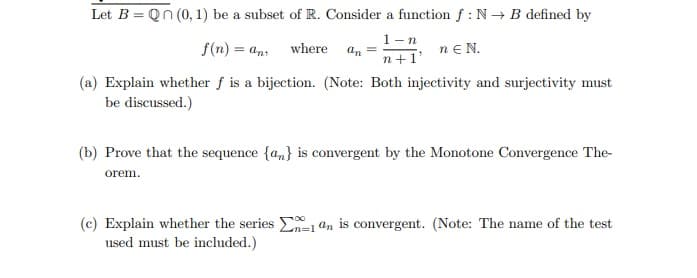Let B = Qn (0, 1) be a subset of R. Consider a function f: N→ B defined by 1-n f(n) = ans where an= nEN. n+1' (a) Explain whether f is a bijection. (Note: Both injectivity and surjectivity must be discussed.)
Let B = Qn (0, 1) be a subset of R. Consider a function f: N→ B defined by 1-n f(n) = ans where an= nEN. n+1' (a) Explain whether f is a bijection. (Note: Both injectivity and surjectivity must be discussed.)
Algebra & Trigonometry with Analytic Geometry
13th Edition
ISBN:9781133382119
Author:Swokowski
Publisher:Swokowski
Chapter10: Sequences, Series, And Probability
Section10.1: Infinite Sequences And Summation Notation
Problem 72E
Related questions
Question
question A

Transcribed Image Text:Let B = Qn (0, 1) be a subset of R. Consider a function f: N→ B defined by
1-n
f(n) = an where an =
nEN.
n+1'
(a) Explain whether f is a bijection. (Note: Both injectivity and surjectivity must
be discussed.)
(b) Prove that the sequence {a} is convergent by the Monotone Convergence The-
orem.
(c) Explain whether the series 1 an is convergent. (Note: The name of the test
used must be included.)
Expert Solution
This question has been solved!
Explore an expertly crafted, step-by-step solution for a thorough understanding of key concepts.
Step by step
Solved in 2 steps with 2 images

Recommended textbooks for you

Algebra & Trigonometry with Analytic Geometry
Algebra
ISBN:
9781133382119
Author:
Swokowski
Publisher:
Cengage

Algebra & Trigonometry with Analytic Geometry
Algebra
ISBN:
9781133382119
Author:
Swokowski
Publisher:
Cengage